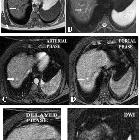dysplastische Leberknoten

Qualitative
analysis of small (≤2 cm) regenerative nodules, dysplastic nodules and well-differentiated HCCs with gadoxetic acid MRI. MR scans in a patient with chronic hepatitis, HCV related, and HCC and dysplastic nodule in liver segment V. a-b T2- and T1-weighted fast images show a heterogeneous nodule in liver segment V (arrow). The lesion shows the typical pattern of HCC with enhancement during the arterial phase c) and a wash-out sign on late dynamic phase d). On the late dynamic phase, a lesion near the “hilum-hepatis” is also detectable with loss of signal intensity to the surrounding liver parenchyma (open arrow). e On the fat-suppressed T1 -weighted 3D GRE image obtained during the hepatobiliary phase at 20 min after contrast injection, both lesions are hypointense to the surrounding liver parenchyma. f Histological analysis shows a hepatocellular carcinoma (upper image) and dysplastic nodule (lower image)

A small
hepatic nodule ( ≤2 cm) in cirrhotic liver: doTriphasic MRI and Diffusion-weighted image help in diagnosis. A 54-year-old male presented with loss of appetite. a An axial unenhanced T1W image shows the right lobe segment IV focal lesion of high signal intensity (arrow). b An axial T2W image shows a lesion of low signal intensity (arrow). c An axial post-contrast arterial phase image showed homogeneous contrast uptake (arrow). d, e An axial portal and delayed images showed persistent contrast enhancement (arrow). f DWI shows the lesion to be of low signal due to non-restricted diffusion (arrow) with an ADC value of 0.7 × 10−3 mm2/s. Suggested MR diagnosis: dysplastic nodule. Biopsy results: high-grade dysplastic nodule
dysplastische Leberknoten
Siehe auch:
und weiter:


 Assoziationen und Differentialdiagnosen zu
Assoziationen und Differentialdiagnosen zu 
